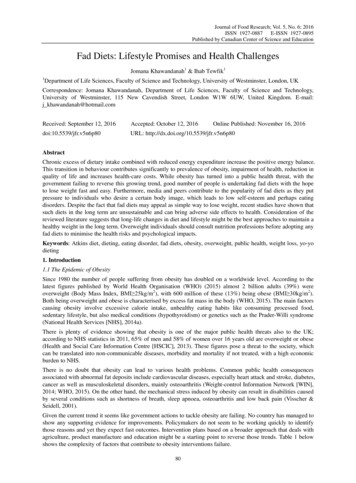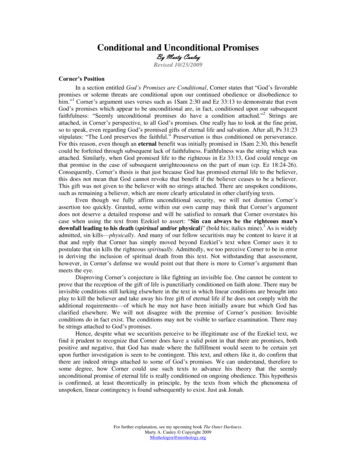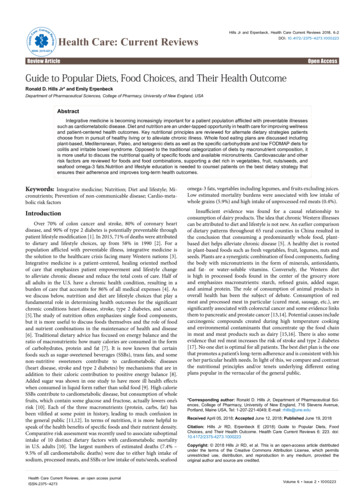
Transcription
Journal of Food Research; Vol. 5, No. 6; 2016ISSN 1927-0887E-ISSN 1927-0895Published by Canadian Center of Science and EducationFad Diets: Lifestyle Promises and Health ChallengesJomana Khawandanah1 & Ihab Tewfik11Department of Life Sciences, Faculty of Science and Technology, University of Westminster, London, UKCorrespondence: Jomana Khawandanah, Department of Life Sciences, Faculty of Science and Technology,University of Westminster, 115 New Cavendish Street, London W1W 6UW, United Kingdom. E-mail:j khawandanah@hotmail.comReceived: September 12, 2016Accepted: October 12, 2016Online Published: November 16, 2016doi:10.5539/jfr.v5n6p80URL: ic excess of dietary intake combined with reduced energy expenditure increase the positive energy balance.This transition in behaviour contributes significantly to prevalence of obesity, impairment of health, reduction inquality of life and increases health-care costs. While obesity has turned into a public health threat, with thegovernment failing to reverse this growing trend, good number of people is undertaking fad diets with the hopeto lose weight fast and easy. Furthermore, media and peers contribute to the popularity of fad diets as they putpressure to individuals who desire a certain body image, which leads to low self-esteem and perhaps eatingdisorders. Despite the fact that fad diets may appeal as simple way to lose weight, recent studies have shown thatsuch diets in the long term are unsustainable and can bring adverse side effects to health. Consideration of thereviewed literature suggests that long-life changes in diet and lifestyle might be the best approaches to maintain ahealthy weight in the long term. Overweight individuals should consult nutrition professions before adopting anyfad diets to minimise the health risks and psychological impacts.Keywords: Atkins diet, dieting, eating disorder, fad diets, obesity, overweight, public health, weight loss, yo-yodieting1. Introduction1.1 The Epidemic of ObesitySince 1980 the number of people suffering from obesity has doubled on a worldwide level. According to thelatest figures published by World Health Organisation (WHO) (2015) almost 2 billion adults (39%) wereoverweight (Body Mass Index, BMI 25kg/m2), with 600 million of these (13%) being obese (BMI 30kg/m2).Both being overweight and obese is characterised by excess fat mass in the body (WHO, 2015). The main factorscausing obesity involve excessive calorie intake, unhealthy eating habits like consuming processed food,sedentary lifestyle, but also medical conditions (hypothyroidism) or genetics such as the Prader-Willi syndrome(National Health Services [NHS], 2014a).There is plenty of evidence showing that obesity is one of the major public health threats also to the UK;according to NHS statistics in 2011, 65% of men and 58% of women over 16 years old are overweight or obese(Health and Social Care Information Centre [HSCIC], 2013). These figures pose a threat to the society, whichcan be translated into non-communicable diseases, morbidity and mortality if not treated, with a high economicburden to NHS.There is no doubt that obesity can lead to various health problems. Common public health consequencesassociated with abnormal fat deposits include cardiovascular diseases, especially heart attack and stroke, diabetes,cancer as well as musculoskeletal disorders, mainly osteoarthritis (Weight-control Information Network [WIN],2014; WHO, 2015). On the other hand, the mechanical stress induced by obesity can result in disabilities causedby several conditions such as shortness of breath, sleep apnoea, osteoarthritis and low back pain (Visscher &Seidell, 2001).Given the current trend it seems like government actions to tackle obesity are failing. No country has managed toshow any supporting evidence for improvements. Policymakers do not seem to be working quickly to identifythose reasons and yet they expect fast outcomes. Intervention plans based on a broader approach that deals withagriculture, product manufacture and education might be a starting point to reverse those trends. Table 1 belowshows the complexity of factors that contribute to obesity interventions failure.80
http://jfr.ccsenet.orgJournal of Food ResearchVol. 5, No. 6; 20161.2 Health Practices: Healthy Eating and Physical ActivityThere is no doubt that adjusting the daily nutritional intake and eating habits can have a major impact on weightmanagement. In order to lose weight, the daily energy expenditure has to be greater than the consumed energyintake; therefore reducing the daily calories can help towards this goal. Healthy eating together with beingphysically active should be the right choice for obese individuals if they want to achieve long-term weight loss(NHS, 2014b). However, current lifestyles and easy access to cheap junk food has resulted in unhealthy eatingbehaviours and a routine with minimal physical activity (NHS, 2013).Table 1. Failure and factors shaping obesity in developed countries (Source: Lang & Rayner, 2007)FocusoffailureMarketsFactors shaping obesityDomainsTransitionsBodyMindDiet Highlight and over- supply Appeal to pleasure particular Build brand value over nutritionalinappropriate, energy- dense Glamorise private motor transportconsciousness(sweet and fat)valuefoods cheaplyrather Barrage consumers with Invest in technical fixes Exploit vulnerable groups (e.g. and single-factor solutionschildren and low income)investments Adopt inconsistent modes Limit health education to become a Subsidise overproduction of Oversee decline of physical activity Permit genderised andof protection (interventionsminor partner of market information,fat and sugar compared with(transport,inadequate food literacy andon sexual protection but notgenerating asymmetry of informationmicronutrient-rich foodsfacilities)skillsnutrition)flow and education Emphasize food safety while Prioritise car use in retail and semi-abandoning nutritiontransport planningindividualized mitedPhysical activityCulture Promote fossil-based fuels Market and mould kforcefoodanddrink as entertainmenttrainingGovernments Aremoderniseunwillingpublictohealthscope and capacitypublicspaces,sportsPromote De-emphasize nutrition and food marketing Confuse citizenship withmarketplacemeritocracy(everyone is equal in themarket)Consumers Disconnect appetite from Adopt distorted images of body Eat a price-led rather than Bow to the ubiquity of the need and satietyacceptabilitynutrition-led dietnon-energy-expendingexpend energy as the norm Accept temporality (short-termism) Respond individually ratherworldof choicethan en masse to identity criseswork/shop/school) Participate in physicalabout meaning and values Are disinclined to build exerciseactivityinto daily nof consumer culturebyproxy(TV Accept inequalities orindulge in victim-blamingIndividuals tend to ignore that the way we approach or manage the process of change, and potentially weight loss,plays an important role. As discussed by Strecher et al. (1995), setting goals can have beneficial effects in healthbehaviour change and maintenance interventions. Cognitive behavioural therapy (CBT) strategies includespecific goal setting, self-monitoring, feedback and reinforcement from outside sources, boosting the confidencein succeeding as well as the use of incentives.2. Fad DietsAs a consequence, people are more susceptible to adopt various fad diets that claim to aid in losing weight veryfast. As stated in CDC's “Healthy Weight – It's not a diet, It's a lifestyle!” a fad diet is any weight loss plan thatpromises quick results and is usually a temporary nutritional change (Centers for Disease Control and Prevention[CDC], 2014). These diets are considered unhealthy as they provide individuals with less calories and nutrients.2.1 History of Fad DietsFad diets are known for centuries. Since ancient times, it was reported that Greeks and Romans had used them;however, at that time it was more about a healthy and active lifestyle. It was Victorians later who actuallyadopted fad diets. According to Foxcroft (2011) in her book „Calories & Corsets: A History of Dieting Over 2000 Years‟, the word diet originates from the Greek word diaita, which represents a way of life including mentaland physical health. It was in the 19th century that people started dieting for aesthetic purposes.One of the most famous dieter of all time was Lord Byron, who in 1820 made the Vinegar and Water Diet verypopular (Foxcroft, 2011). A century later, the Grapefruit Diet was created, where eating grapefruit with eachmeal was suggested as part of a low calorie diet plan. Interestingly, the Lucky Strike cigarette company launchedthe known Cigarette Diet based on the appetite suppressing effects of nicotine. Later in 1963, Jean Nidetch81
http://jfr.ccsenet.orgJournal of Food ResearchVol. 5, No. 6; 2016founded Weight Watchers and in 1970 the „sedative‟ Sleeping Beauty Diet became famous (Rotchford, 2013).The last few decades, fad diets, such as The Atkins and Dukan Diets, became well known, based on high-proteinand low-carbohydrate intake (Hughes, 2012). Other examples include the Zone Diet, suggesting a certain ratio offat protein and carbohydrates, the South Beach Diet, which is a lighter version of Atkins Diet and the MasterCleanse, a diet based mostly in liquid food (Rotchford, 2013). Figure 1 demonstrates the most important dietsthroughout history.2.2 How to Identify a Fad DietA fad diet is usually described as a weight loss plan that guarantees quick weight loss and dramatic results withno much effort. There are various types of fad diets that can be recognized; however, all of them share somecommon characteristics (Bastin, 2004). All fad diets promise fast weight loss (more than 1 kg a week) withoutgiving away fatty, rich-in-calories food and without the need to regularly exercise. Most fad diets limit the rangeof food types included in the meal plan and do not reassure a balanced and healthy diet. They usually propose„miracle‟ foods that need to be consumed in abnormal quantities and help fat burning with a minimal effort.Some focus on consuming large quantities of one food type that could result in intestinal disturbance, bloating,bad breath and nutritional imbalances (Bastin, 2004).Fad diets are usually promoted by „before and after‟ images of successful examples of people that have followedthe particular diet or by „experts‟ in the field of nutrition. However, no health warnings about possibleconsequences of adopting these fad diets on individuals with chronic diseases are included in the advertisements.Most fad diets are usually based in no or limited research and can lead to serious health impacts (Bastin, 2004).2.3 Popular Fad DietsAs mentioned before, there is a wide range of proposed fad diets over the last centuries, which are summarised inTables 2 and 3. They can be categorised into several main groups including low-/no- carbohydrate,high-carbohydrate/high-fibre as well as the liquid formula diets (Bastin, 2004; British Dietetic Association[BDA], 2014).Figure 1. History of dieting over time including the most popular fad diets (adjusted from Rotchford, 2013)82
http://jfr.ccsenet.orgJournal of Food ResearchVol. 5, No. 6; 2016When following a low- or no-carbohydrate diet, a high intake of protein and/or fat is recommended. Example faddiets of this type include the Atkins diet, the Dukan diet, the South Beach diet and the Grapefruit diet. Thesediets are particularly popular as due to the low intake of energy through carbohydrates, a rapid weight lossmainly due to water loss occurs immediately. The success of such a „ketogenic‟ diet together with high proteinconsumption promotes great weight loss by increasing satiety, which makes it easier to adhere (Geissler &Powers, 2005). However, it is common that the weight is gained back once the diet is discontinued as the bodytries to „correct‟ the water imbalance (Bastin, 2004) (Figure 2). Although the diet‟s claimed weight losscompared to conventional energy-restricted diets has been demonstrated in controlled trials (Foster et al., 2003),its long-term effects are still being investigated by the scientific community.These diets can be quite dangerous due to the ketone formation in excess amounts as a result of incomplete fatbreakdown and dehydration. Ketones are stored in blood and can even lead to death if the diet is continuedlong-term. The Recommended Dietary Allowance (RDA) for carbohydrates is 130 grams per day for both adultsand children as an average minimum intake of glucose used by the brain for normal function (Food and NutritionBoard, Institute of Medicine, 2005).Table 2. Types of fad diets (adjusted from Bastin, 2004; BDA, 2014)Diet typeLow carbohydrates ( 100g/day)Extremely low fat ( 20% kcal from fat/day)CombinationVery low kcalorie ( 800 kcal/day)Novelty (certain nutrients or foods)FormulaPre-measuredDetoxHigh fatHigh proteinKnown examples Atkins Diet Revolution South Beach Diet Pritikin Diet Pasta Diet Fit for Life Zone Diet Cambridge Diet Rotation Diet Beverly Hills Diet Junk Food Diet Slim Fast Last Chance Diet Jenny Craig Nutri-System The Master Cleanse Ketogenic Diet Dukan Diet Bodybuilder DietTable 3. Main categories of fad diets as suggested by the BDAHigh-proteinLow-CarbohydrateAtkinsDukanSouth BeachZoneModerate-fatLow-carbohydrateJenny CraigNutri-SystemWeight WatchersLow-fatVery-high-carbohydrateOrnishThe New Pritikin programLEARNVery-low-calorieBernsteinLighter LifeSlim FastOn the other hand, high-carbohydrate/high-fibre-diets are also popular, including the Pritikin diet plan andSave-Your-Life diet. This type of diets provide with low levels of both proteins and fats, which can lead toreduced immunity and problematic wound healing (Bastin, 2004). Furthermore, the liquid formula diets containvery limited calorie intake (often 400-500 calories) and promise to supply with the necessary nutrients. Anexample of a very low-calorie diet is the Cambridge diet. These diets should be adopted with caution as theself-prescribed starvation be linked with health risks and serious illnesses such as anaemia, reduction of vitaminsand minerals supply, fatigue as well as weakness and dizziness. Lastly, diets suggesting the consumption of onlyone food group like the Cider Vinegar and Vitamin B6 Diet are also popular but can cause malnutrition andreduced renal function (Bastin, 2004).83
http://jfr.ccsenet.orgJournal of Food ResearchVol. 5, No. 6; 20163. Causes Leading to Fad Dieting3.1 The Effect of Peer PressureFollowing a fad diet is often a result of peer pressure. Peer pressure occurs when people of the same ageinfluence an individual‟s behaviours and decisions by making the person feeling uncomfortable, including theway of thinking of themselves, dressing and eating. Peer pressure originates not only from family and friends butalso from the outside environment (Berry, 1999). Criticism of weight and diet by peer members is associatedparticularly with dieting in teenagers (Cattarin & Thompson, 1994). The ideal body image introduced by peerscan lead to feelings of inferiority, low self-esteem and depression. Emotions of guilt and unattractiveness arestrongly developed causing individuals to adopt fad diets to make themselves more likable. These individualsappear to be obsessed with their appearance, weight and popularity within their peers that results in inefficientdieting (Berg, 1996).Figure 2. Average weight changes amongst subjects on a low-carbohydrate diet and alow-calorie/high-carbohydrate conventional diet (adapted from Foster et al., 2003)Furthermore, possible failed attempts to quickly lose weight can lead to depression and „yo-yo‟ dieting. Extremeweight loss followed by quick weight gain is associated with many health risk factors such as heart disease,cancer, diabetes, increased in LDL cholesterol as well as reduced muscle and energy. It is believed that thesenegative health impacts are linked with the stress hormone called cortisol (McNight, 2013). These feelings andcontinuous dieting can result in unhealthy eating habits, which can continue over someone‟s lifetime (Berry,1999). The fear of being fat can also lead to eating disorders from a young age, such as anorexia nervosa andbulimia. In both disorders, sufferers show body image distortions and feelings of anxiety and shame about eating(Human Diseases and Conditions [HDC], 2014).3.2 The Effect of Media on Body Image and Self-EsteemOver the last decade, statistics have shown an increase in people suffering from eating disorders in manysocieties due to the continuous value that they put on being thin. In every aspects of someone‟s life, such asgoing for shopping, watching television, reading fashion magazines and following favourite celebrities, the verythin figure is linked with a happy and successful life. Therefore, thousands of teenagers are exposed to the „ideal‟,unrealistic image of models, who according to medical standards, try to maintain a 15% below normal weightand meet the criteria for anorexia (Mirror Mirror Eating Disorders [MMED], 2014). Television, movies andsocial media are full of diet advertisements about food supplements, diet programs and in general chemicallybased ways to lose weight. Every month new novel diets promise to cause dramatic changes to the appearance ofoverweight people; probably due to the fact that all previous diets did not work and are rather unhealthy (MMED,2014). The inevitable effects of food advertising on eating behaviours was studied in elementary-school-agedchildren which received a snack after watching a cartoon with either a food advertisement or one about otherproducts (Harris, Bargh, & Brownell, 2009). The results showed that children consumed 45% more snacks (28.5gr) when exposed to the food advertisements than their controls (19.7 gr) (Harris et al., 2009).84
http://jfr.ccsenet.orgJournal of Food ResearchVol. 5, No. 6; 2016Apart from advertisements, television and fashion magazines also include articles or reports about appearancemeaning how to look perfect, how to be in shape, how to apply makeup or suggestions about clothing.Magazines are also full of photos that have previously been photo-shopped containing wrinkle-free faces andfat-free bodies which are idealistic and far from reality (Education.com, 2014). A study has found that 69% ofteenage girls agreed that the photos in magazines affected their idea of the „ideal‟ body image, while 47% saidthat as a result they desired to lose weight (Field, 2000). The frequency of reading magazine‟s articles aboutweight loss and diets increases the possibilities of adopting unhealthy eating and weight control behaviours likeskipping meals and fasting, especially among teenagers (Van den Berg, Neumark-Sztainer, Hannan, & Haines,2007).4. Weighing Short-Term Pros against Long-Term ConsTable 4 summarises the advantages and drawbacks of the main categories of fad diets, which are discussed inmore detail below.Table 4. Advantages and disadvantages of fad diets as suggested by the BDA (2014)4.1 Benefits of Fad DietsFad diets are usually known for showing drastic results and some of them can actually offer some benefits. Thereare plenty of benefits when following a low-carbohydrate diet. Atkins diet is known for the suppression ofappetite and its anorectic properties, mainly due to the high protein intake (McClernon, Yancy, Eberstein, Atkins,& Westman, 2007). It results in a rapid weight loss, especially during the first few weeks. In a controlled study of63 obese patients, Atkins diet resulted in a weight loss of 6.8% body weight after three months compared to 2.7%accomplished by an energy-restricted diet (Foster et al., 2003). Low-carbohydrate diets have also a greatpotential in eliminating a larger proportion of abdominal fat (Volek et al., 2004). In addition, carbohydraterestriction can be efficient in significantly lowering both the plasma LDL cholesterol and triglyceride following atwelve-week weight loss intervention (Wood et al., 2006). At the same time, HDL levels can be dramaticallyincreased because of the high-fat consumption included in Atkins diet (Brinkworth, Noakes, Buckley, Keogh, &Clifton, 2009). Furthermore, in a study testing the effect of a low-carbohydrate diet in type 2 diabetes, it was85
http://jfr.ccsenet.orgJournal of Food ResearchVol. 5, No. 6; 2016reported that most patients improved their glycemic index and reduced or eliminated medication control withinsix months (Westman et al., 2007). Lastly, Atkins diet has shown to reduce blood pressure short-term, thereforeleading to a decreased risk of developing cardiovascular diseases (Gardner et al., 2007).The proposed meal plans such as in many Detox diets or the Grapefruit diet often consist of lots of fruits andvegetables. These food types are popular for being healthy and beneficial but of low calories at the same time.Fad diet users will therefore supply with many vitamins, minerals and antioxidants. Following these eating habitsalso helps in promoting physical and psychological health. A person that loses weight firstly reduces the riskslinked with obesity and secondly feels lighter, healthier and with increased self-confidence (Health ResearchFunding [HRF], 2014). Moreover, adopting a fad diet can help someone recognise which characteristics ofhis/her current diet are responsible for the excess weight. Fad diet programs like the French Woman‟s diet canalso help establish the right portion sizes and avoid unwanted snaking (Cespedes, 2014).4.2. Health consequences of fad dietingOn the other hand, fad diets do not come without disadvantages. Weight loss occurs too fast, most of the lostweight being water and muscle, not fat tissue. Rapid weight loss can further lead to various health risks such asconstipation, low nutrients and energy intake and tiredness, all caused by eating less calories (HRF, 2014).Fad diets, especially the low-carbohydrate/high-protein diets such as The Dukan diet, involve physiologicalaspects; they limit the amount of carbohydrate and sugar intake and at the same time promote the consumptionof animal protein. As a result, there is a shift from using glucose to using fatty acids and ketones as the main fuelsources; therefore, the glycogen availability increases (Westman et al., 2007). Ketosis could then result in adecrease of appetite but also cause hyperuricemia since ketones compete with urine acid for renal tubularexcretion (Denke, 2001). Despite the reputation of the ketogenic diets there is little scientific support of theirlong-term side effects and sustainability. In order to suggest the adaptation of such diets as a „life nutritionalphilosophy‟, possible adverse effects on health and disease prevention need to be studied.Studies have shown that high-fat/high-protein diets like The Atkins diet also result in higher risk of heart disease(WHO/Food & Agriculture Organisation Expert Consultation, 2013), colon cancer (Giovannucci et al., 1994),bad breath (Mahon & Escott-Stump, 1996) and sleeping disorders (Fitness, 2014). Anderson, Konz, and Jenkins(2000) showed that the Atkins diet increase the cholesterol levels in the serum, increasing the risk ofatherosclerosis and coronary heart disease by greater than 50% if used in long term. Various adverse effects offollowing a very-low-carbohydrate short-term diet have previously been reported including constipation due tolow fibre intake (68% of participants), bad breath (63%), headache (51%), hair loss (10%) and increasedmenstrual bleeding (3%) (Westman, Yancy, Edman, Tomlin, & Perkins, 2002).High-protein diets have been linked with a greater production of nitrogen waste products, which add a pressureon the kidneys, especially in dehydration state (Denke, 2001). Another study has shown that after six weeks ofsuch a diet there is an increased acid load to the kidney maximising the possibility of stone formation and adecrease of calcium balance leading to bone loss and osteoporosis (Reddy, Wang, Sakhaee, Brinkley, & Pack,2002). Consuming two or three times more protein than the recommended daily allowance has been associatedwith loss of calcium through the urinary tract, which could predispose to bone loss long-term (Eisenstein,Roberts, Dallal, & Saltzman, 2002). Although significant reduction in insulin responses has been observed after alow-carbohydrate diet (Westman et al., 2007), it is believed that insulin sensitivity and resistance may benegatively influenced in the long-term (Riccardi, Giacco & Rivellese, 2004; Shulman, 2000). Moreover,following such a diet for several months can cause an increase in plasma homocysteine (Clifton, Noakes, Foster,& Keogh, 2004), the effect of which has been linked with higher cardiovascular risk (Refsum, Ueland, Nygard,& Vollset, 1998).On the other hand, low-protein/low-fat diets might increase the risk of inadequate intake of minerals such ascalcium and zinc as well as high-quality protein. For example when following the Pritikin diet the recommendedfat intake should be less than 10% of the daily energy intake which is close to the lowest limit of the dailyrequirement for essential fatty acids (Pritikin, 1981). Other nutritional deficiencies, such as iron deficiency, canbe associated with growth decrease and anaemia in adolescents (Dietz & Hartung, 1985). Additionally, adoptingunbalanced eating habits has been connected with menstrual irregularity or amenorrhea (Kreipe, Strauss,Hodgman, & Ryan, 1989). Table 5 summarises the most popular fad diets, their main components and theirphysiological implications, the main of which are explained below.4.3 Psychological ImplicationsStudies in adults have suggested that constant dieting (yo-yo dieting) is associated with a range of symptoms86
http://jfr.ccsenet.orgJournal of Food ResearchVol. 5, No. 6; 2016such as food obsession, constant calorie counting, distractibility, increased emotional responsiveness and fatigue(Polivy, 1996). Chronic dieters also tend to overeat, have low self-esteem as well as suffer from some eatingdisorders and depression (Polivy, 1996). It is known that these effects are particularly true in children andteenagers, causing complicated consequences in their social and psychological development (CanadianPaediatric Society [CPS], 2004). From previous studies it has been shown that following a structured,multidisciplinary weight loss regime might have a negative effect on the self-esteem of both children (Cameron,1999) and adolescents (Stice, Cameron, Killen, Hayward, & Taylor, 1999). Current research has linked dietingwith higher risk of developing disordered eating as well as a trend to overeat; however, the causes are stillunclear or controversial (Polivy, 1996). Lastly, self-directed dieting early in life (9-14 years old) has beenassociated with weight gain overtime in large-scale, 3-year-long study involving more than 15 000 subjects(Field et al., 2003).4.4 Safety of Fad DietsFad diets promise quick weight loss but are generally thought to be unhealthy and temporary. Weighing theadvantages over the drawbacks of fad dieting can be hard but necessary since there is no scientific evidenceproving their safety. According to NHS (2013) in 2011 the BDA had warned against many fad diets since theywere not based on clinical trials and reportedly did not give rise to long-term results. Also, most of these dietsoveremphasise one particular food type (for example the Banana or the Rice diet) and are considered dangerousand nutritionally unbalanced. Furthermore, there is not always supplementary scientific evidence to support theproposed claims (Fisher, 2011).5. Sustainability of Weight Loss by Fad DietsFurthermore, the strict regime of fad diets makes it very difficult to commit as eating low-calorie foods requiresboth preparation and lifestyle change (HRF, 2014). It is common that most of dieters regain the weight they havelost - or even more within a few months - a situation that leads to yo-yo dieting. It is believed that it is very hardto maintain a fad diet long-term as the dieters revert back to their previous eating habits at some point. Thomas,Hyde, Karunaratne, Kausman, and Komesaroff (2008) conducted a study on obese subjects and found that theywere unable to commit to these diets for various reasons such as unsuitable or costly diet, concordance with theirlifestyle and monotony in food choices.Foster et al. (2003) showed that although following a low-carbohydrate diet produced a larger weight losscompared to the conventional diet at six months period, the difference was not statistically significant after a year.Moreover, these findings are supported by a study published in 2006 from the BBC ”diet trials”. Thisrandomized controlled study compared the effectiveness of four popular fad diets in the UK over six monthsincluding the Dr Atkins‟ new diet revolution, the Slim-Fast plan, the Weight Watchers pure points plan, and theRosemary Conley‟s eat yourself slim diet and fitness plan (Truby et al., 2006). The trial was based in 293 healthyoverweight or obese adults, who all succeed a significant loss of both weight and body fat regardless of the faddiet followed. Although the Dr Atkins‟ new diet revolution resulted in higher weight loss during the first month,there were no statistically significant differences among the diet plans after 6 months. The study also showed thatthe initial sustainability was not feasible over a long period of time as demonstrated in Figure 3. These findingsare also supported by the review conducted by Jebb and Goldberg (1998); however, it was also shown that therewas a small portion of participants (3-4% based on 381 subjects) that
Other examples include the Zone Diet, suggesting a certain ratio of fat protein and carbohydrates, the South Beach Diet, which is a lighter version of Atkins Diet and the Master Cleanse, a diet based mostly in liquid food (Rotchford, 2013). Figure 1 demonstrates the most important diets throughout










